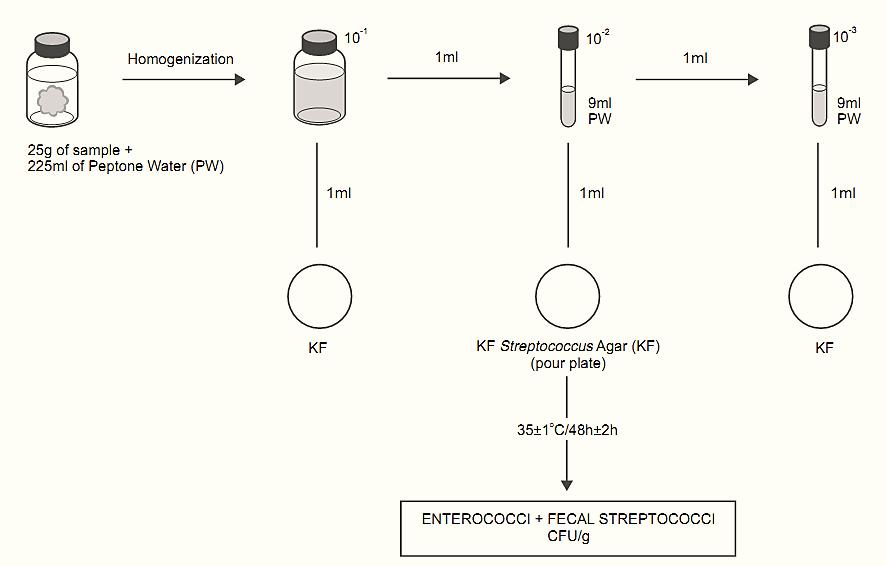


 النبات
النبات
 الحيوان
الحيوان
 الأحياء المجهرية
الأحياء المجهرية
 علم الأمراض
علم الأمراض
 التقانة الإحيائية
التقانة الإحيائية
 التقنية الحيوية المكروبية
التقنية الحيوية المكروبية
 التقنية الحياتية النانوية
التقنية الحياتية النانوية
 علم الأجنة
علم الأجنة
 الأحياء الجزيئي
الأحياء الجزيئي
 علم وظائف الأعضاء
علم وظائف الأعضاء
 الغدد
الغدد
 المضادات الحيوية
المضادات الحيوية| Plate count method APHA 2001 for enterococci and fecal streptococci in foods |
|
|
|
Read More
Date: 3-3-2016
Date: 2-3-2016
Date: 14-3-2016
|
Plate count method APHA 2001 for enterococci and fecal streptococci in foods
Method of the American Public Health Association (APHA), as described in 4th Edition of the Compendium of Methods for the Microbiological Examination of Foods (Hartman et al., 2001). Also are included recommendations from the 17th Edition of the Standard Methods for the Examination of Dairy Products (Frank & Yousef, 2004), for dairy products analysis. Not applicable to water samples.
1 - Material required for analysis
Preparation of the sample and serial dilutions
• Diluent: 0.1% Peptone Water (PW) or Butterfield’s
Phosphate Buffer
• Dilution tubes containing 9 ml of 0.1% Peptone Water (PW) or Butterfield’s Phosphate Buffer
Plate count
• KF Streptococcus (KF) Agar
• Citrate Azide Agar (for dairy products analysis)
• Laboratory incubator set to 35 ± 1°C
2- Procedure
A general flowchart for the determination of enterococci or fecal streptococci by the plate count method APHA 2001 is shown in Figure 1.
a) Preparation of the samples and inoculation.
For dried foods the Compendium recommends to pre-pare a 1:1 initial dilution (sample 25 g+ diluent 25 ml), let it stand at 4°C/60 min and add the remaining volume of diluent to obtain a 1:10 dilution. Select three appropriate dilutions of the sample and inoculate on KF Streptococcus (KF) Agar (pour plate). For dairy products, use Citrate Azide Agar instead of KF and after inoculation cover (overlay) the surface with a 5–8 ml layer of the same medium.
b) Incubation: Incubate the plates of KF Agar at 35 ± 1°C/48 ± 2 h. Incubate the plates of Citrate Azide Agar at 37 ± 1°C/48–72 h.
c) Colony counting and calculation of results KF Agar: Select plates with 25–250 colonies and count only the typical red or pink colonies as enterococci + fecal streptococci. Determine the number of CFU/g or ml by multiplying the number of typical colonies by the inverse of the dilution.
Citrate Azide Agar: Select plates with 25–250 colonies and count only the typical blue colonies as enterococci + fecal streptococci. Determine the number of CFU/g or ml by multiplying the number of typical colonies by the inverse of the dilution.

Figure.1 Scheme of analysis for the enumeration of enterococci and fecal streptococci in foods using the plate count method APHA 2001 (Hartman et al., 2001).
References
Silva, N.D .; Taniwaki, M.H. ; Junqueira, V.C.A.; Silveira, N.F.A. , Nasdcimento , M.D.D. and Gomes ,R.A.R .(2013) . Microbiological examination methods of food and water a laboratory Manual. Institute of Food Technology – ITAL, Campinas, SP, Brazil .



|
|
|
|
تحذير من "عادة" خلال تنظيف اللسان.. خطيرة على القلب
|
|
|
|
|
|
|
دراسة علمية تحذر من علاقات حب "اصطناعية" ؟!
|
|
|
|
|
|
|
العتبة العباسية المقدسة تحذّر من خطورة الحرب الثقافية والأخلاقية التي تستهدف المجتمع الإسلاميّ
|
|
|